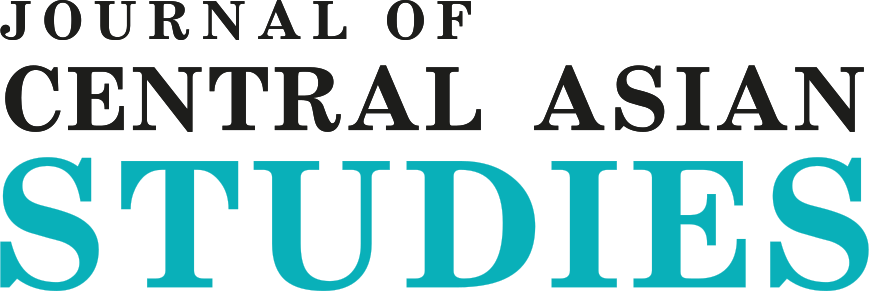Орталық Азиядағы діни экстремизм және терроризм мәселелері: радикалды топтарға шолу
DOI:
https://doi.org/10.52536/3006-807X.2024-4.004Кілт сөздер:
Діни экстремизм, терроризм, қауіпсіздік, ДАИШ, лаңкестік топтар, Орталық Азия содырлары. , діни экстремизм, терроризм, қауіпсіздік, ДАИШ, лаңкестік топтар, Орталықт Азия содырларыАңдатпа
2019 жылдың қаңтарында АҚШ «Ислам мемлекеті» лаңкестік ұйымын (бұдан әрі – ДАИШ) жеңгенін жариялады. Осылайша ДАИШ-ке қарсы ұзақ мерзімді халықаралық күресте уақытша қорытынды жасалды. Дегенмен, тұрақсыздық аймақтары радикалды топтарды кеңінен тартуда. Бүгінде олар Сирияның Идлиб провинциясында, Ливанда, Малиде және Нигерияда жұмыс істейді. Өз кезегінде, 2021 жылы Талибан Ауғанстанда билікке келіп, Орталық Азия+ аймағындағы статус-квоны түбегейлі өзгертті. 2023 жылдың қазан айында Газадағы әскери операция басталды, ол да әртүрлі террористік ұйымдарды күшейтіп, жаһандық идеологиялық алшақтықты көрсетті. Соңғы онжылдықта «жаһандық жиһад» орталығына айналған Сирия мен Ауғанстанда болып жатқан оқиғалар аясында Орталық Азиядан келетін лаңкестік және экстремистік ұйымдар төндіретін ықтимал қауіптер маңызды ғылыми қызығушылық тудырады.
Бұл мақаланың мақсаты – Орталық Азиядан келген иммигранттармен негізгі радикалды топтардың қызметін талдау. Басты қызығушылық Сирия мен Ауғанстанда Орталық Азия содырлары топтарының институционализациясының белсенді процесі жүріп жатқандығымен байланысты. Бұл жаңа бірлестіктердің пайда болуына алып келді. Ғылыми жұмыс аясында діни экстремизмнің таралу жолдары зерделеніп, Қазақстан мен Өзбекстандағы радикалды топтардың қалыптасу хронологиясы, олардың аймақтық қауіпсіздіктің жалпы архитектурасындағы орны көрсетілді. Мақаланың жаңалығы – діни экстремизм мен терроризм Орталық Азия аймағындағы жағдайды тұрақсыздандыратын негізгі факторлардың біріне айналатынын болжайтын қалыптасқан үрдістерге баға беру болып табылады.
Орталық Азия елдерінің бар қауіп-қатерлерді еңсеру үшін өздерінің ішкі мүмкіндіктерін жұмылдыра алуы аймақтың қауіпсіз, бәсекеге қабілетті және дамыған өңір ретіндегі болашақ перспективаларын болжауға елеулі әсер етеді.
Әдебиеттер тізімі
Anti-Terrorist Center of CIS Member States. (2016). The State Committee for National Security of Kyrgyzstan identified the organizers and perpetrators of the attack on the Chinese Embassy in Kyrgyzstan. CIS ATC. https://www.cisatc.org/news/8500
Burke, J. (2024). Islamic State recruiting from Tajikistan and other Central Asian countries. Retrieved from “The Guardian”, 2024 March 24 https://www.theguardian.com/world/2024/mar/24/islamic-state-recruitingmilitants-from-tajikistan-and-other-central-asian-countries
Federal Security Service of the Russian Federation. (2024). The FSB of Russia, in cooperation with Rosfinmonitoring and the Investigative Committee, eliminated an international resource channel for the "Katiba Tawhid wal-Jihad" terrorist group. FSB Press Center. http:// www.fsb.ru/fsb/press/message/single.htm%21id%3D10439924%40fsbMessage.html
Global Terrorism Index (2024). IEP (Institute for Economics and Peace), p. 72-73. https://www.economicsandpeace.org/wp-content/uploads/2024/02/GTI-2024-web-290224.pdf
Hill, F. (2003). Central Asia: Terrorism, religious extremism, and regional stability. Testimony before the House Committee on International Relations, Subcommittee on the Middle East and Central Asia. Retrieved from The Brookings Institution. https://www.brookings.edu/wp-content/uploads/2016/06/20030723-1.pdf
"Islamic Jihad Union": A portrait of a terrorist organization. (2016). Retrieved from Anti-Terror Today. https://antiterrortoday.com/baza-dannykh/terroristicheskie-i-ekstremistskie-gruppirovki/soyuz-islamskogodzhikhada-gruppa-islamskogo-dzhikhada/386-soyuz-islamskogo-dzhikhada-portret-terroristicheskojorganizatsii
The Islamic Movement of Uzbekistan swears allegiance to ISIS. (2015). Retrieved from the Uzbek Service of Radio Free Europe/Radio Liberty. https://rus.ozodi.org/a/27175205.html
Islamists from Central Asia charged in Germany. (2024). Retrieved from Deutsche Welle. https://www.dw.com/ru/v-frg-predavili-obvinenia-islamistam-iz-centralnoj-azii/a-68910952
The "Jaish-ul-Mahdi" case gains new details. (2016). Retrieved from News-Asia. http://www.news-asia.ru/view/9134
Karin, E., & Zenn, J. (2017). Between ISIS and al-Qaeda: Central Asian militants in the Syrian war. Astana Stratcom Team.
Komar, R., Borys, C., & Woods, E. (2017). The Blackwater of Jihad. Foreign Policy. https://foreignpolicy.com/2017/02/10/the-world-first-jihadi-private-military-contractor-syria-russia-malhama-tactical/
A Kyrgyz man was detained on suspicion of participating in hostilities in Syria. (2023). Retrieved from 24.kg. https://24.kg/proisshestvija/ 279371_kyirgyizstantsa_zaderjali_popodozreniyu_vuchastii_vboevyih_deystviyah_vsirii/
The leader of militants from Kyrgyzstan, Sirozhiddin Mukhtarov, was eliminated in Syria. (2022). Retrieved
from Interfax. https://www.interfax.ru/world/861443
Lemon, E. (2018). Talking up terrorism in Central Asia. Kennan Cable No. 38. https://www.wilsoncenter.org/sites/ default/files/media/documents/publication/kennan_cable_38.pdf
Ning, Y., & Wang, T. (2021). Social movements and political struggle in the Middle East: Concepts, mechanisms, and issues—Localization of Salafist studies. Middle Eastern Studies, 1(82).
Olcott, M. B. (2012). In the whirlwind of jihad. Carnegie Foundation. Post-Soviet Wahhabism has found its niche in geopolitical confrontation. (2013). Retrieved from the interview with B. Babadzhanov. Regnum. https://regnum.ru/article/1626149
Rehabilitation of "deceived victims" returning from Syria begins in Uzbekistan. (2019). Retrieved from Central Asia News. https://central.asia-news.com/ru/articles/cnmi_ca/features/2019/06/11/feature-01
Serenko, A. (2023). The Taliban are preparing for a big war. Retrieved from Media.az. https://media.az/politics/1067935344/andrey-serenko-taliby-gotovyatsya-k-bolshoy-voyne-intervyu/
Serenko, A. (2024). Islamists in Central Asia start anti-China jihad. Retrieved from Novaya Gazeta. https://www.ng.ru/kartblansh/2024-11-24/3_9141_kb.html
Sharipova, D., & Beissembayev, S. (2021). Causes of violent extremism in Central Asia: The case of Kazakhstan. Studies in Conflict & Terrorism, 46(9), 1-15. https://www.tandfonline.com/doi/full/10.1080/1057610X.2021.1872163
Shibutov, M., & Abramov, V. (2012). Report "Terrorism in Kazakhstan – 2011-2012". Almaty.
The St. Petersburg attack led to Abu Salah. (2017). Retrieved from Gazeta.ru. https://www.gazeta.ru/army/2017/04/21/10638311.shtml
Terrorist attacks, cyber shield, and risks to the economy. (2024). Retrieved from the interview with the head of the National Security Committee of the Republic of Kazakhstan, Yermek Sagimbaev. https://www.gov.kz/memleket/entities/knb/press/news/details/808632?lang=ru
United Nations Security Council (2011). Islamic Movement of Uzbekistan. https://www.un.org/securitycouncil/ru/ sanctions/1267/aq_sanctions_list/summaries/entity/islamic-movement-of-uzbekistan
UN Women (2024). FAQs: Afghan women three years after the Taliban takeover. 20 August 2024. https://eca.unwomen.org/ru/stories/explainer/2024/08/chasto-zadavaemye-voprosy-afganskie-zhenschiny-spustya-trigoda-posle-zakhvata-vlasti-talibanom
U.S. and British intelligence agencies create conditions for instability at the southern borders of the CIS. (2023). Retrieved from interview with the head of FSB, Bortnikov A. TASS. https://tass.ru/politika/18971727
The "Uzbek model" of combating terrorism is attracting interest abroad. (2018). Retrieved from interview with the former minister of foreign affairs of Uzbekistan, V. Norov. Gazeta.uz. https://www.gazeta.uz/ru/2018/11/01/ismi/
Uzbekistan-UNSDCF 2021-2025. United Nations Sustainable Development Cooperation Framework 2021-2025, 24 September 2020. https://unece.org/sites/default/files/2021-05/Uzbekistan-UNSDCF-2021-2025.pdf
The war that never happened: How Kyrgyz citizens who returned from Syria live now. (2019). Retrieved from BBC Russian. https://www.bbc.com/russian/features-47281602
Yudin, N. V. (2016). The "Security — Development" link: Issues of theoretical understanding. Moscow University Bulletin. Series: International Relations and World Politics, 1, 39–70.
Zhang, N. (2020). Analysis of the Current Counter-Extremism Situation in Central Asia. Collection of reports of the Northern Forum (No. 2, Issue 280).
Zhirukhina, E. (2024). Foreign fighters from Central Asia: Between renunciation and repatriation. ISPI.
Жүктеулер
Жарияланды
Журналдың саны
Бөлім
Лицензия
Авторлық құқық (c) 2024 Ахантаева С., Мұсабекова Ә.

Бұл жұмыс Creative Commons атрибуты бойынша лицензияланған. 4.0 Халықаралық лицензия.










 Open content is licensed under the CC-BY
Open content is licensed under the CC-BY 